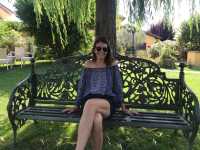
The capital, and largest city, of Bosnia and one of the most underrated destinations in Europe. Since the opening up of the Balkans, as a tourist destination, Sarajevo has grown in popularity and tourists have been welcomed by locals eager to showcase their special city to the world and to ensure that Sarajevo isn’t just defined by the events of the past but recognised for its incredible spirit. This city completely captured my heart.
THE HISTORY
What makes Sarajevo so fascinating isn’t just its turbulent history but the fact that these events happened so recently, especially in terms of European history. It was only in the early nineties that Sarajevo was subject to shelling and sniper attacks in the longest siege of a capital city in the history of modern warfare. The city still bears the scars of the siege. Cemeteries, full of white crosses, dominate the hills around the city and red craters in the streets, known as the Sarajevo roses, mark fatal mortar strikes.
THE TUNNEL
Further outside the city you can take a tour to The Tunnel of Hope - a hand dug tunnel that acted as a lifeline to Sarajevo when it was completely cut off from the outside world during the Bosnian war. Stretching right under the airport landing strip the tunnel was used to bring food, and other supplies, into the city while it was under siege. It’s incredible to see how life was lived here in the early nineties while I was at home listening to my first CD (The Spice Girls, obvs!) and playing with Barbies.
THE BOBSLEIGH TRACK
Most organised tours will also include a visit to the abandoned Bobsleigh track that was built for the 1984 Winter Olympics. Nestled into the woods high up on Mount Trebevic, and covered with graffiti, the track is as creepy as it is cool. Instagramable pictures are aplenty - not just for the colourful shell of the track but for the panoramic views over the whole city.
</div>
View this post on Instagram</div></a> </div>
THE BAZAAR
Right at the heart of the city is the Bascarsija (the cultural and historical centre of Sarajevo) home to the bazaar. Recognisable by the tangle of narrow streets made even narrower by tables and chairs that spill onto the walkways, copper coffee pots stacked up in tottering piles, scarves fluttering from stands and boards displaying jewellery and other trinkets. The bazaar is everything it should be. A gentle bustle, a hum of voices, a kaleidoscope of colours and the haze of wood fires.
THE FOOD
Follow the smoky scent to its origin and you will find a tavern specialising in Cevapi - a small skinless sausage of minced, and questionable, meat served with a big chunk of flat bread, chopped raw onions and yoghurt. The atmosphere is very much that of school cafeteria where locals and tourists sit elbow to elbow scooping messy mouthfuls from the plates and licking their fingers with gusto. It’s not even so much about what you’re eating but how you’re eating it. The authenticity of eating such simple food, with your hands, off copper plates that were probably engraved by the braziers in the coppersmiths street of Bascarsija is an unforgettable experience.
THE MOSQUES
If you’ve never been to a Muslim country before you will be awed by the culture. Hearing the prayer call broadcast from the speakers on top of the minarets makes you feel like you are worlds away from Western Europe. The Gazi Husrev-beg Mosque is the most central and the main congregational mosque in Sarajevo and is a stunning example of classical Ottoman architecture with almost a whole cityscape of domes and arches. It's an active place of prayer so locals leave their shoes on the front steps and kneel on the thick, brightly coloured, carpets (men on one side of the intricate wooden door, women on the other). Tourists are welcome in the courtyard, and even inside certain parts of the mosque, where the hushed and peaceful core is a welcome break after the energy of the bizarre.





